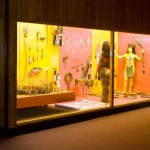
Katherine Abu Hadal, Indian Country Today Media Network
Natural history museums—they are all over the US and abroad too. They house amazing dinosaur fossils, exotic hissing cockroaches, and wondrous planetariums—right next to priceless human-designed art and artifacts created by Native peoples of the Americas.
Like me, you might wonder why these designed objects are juxtaposed with objects of nature such as redwood trees and precious metal exhibits. Yes, of course art is part of the natural world that we live in—but then, why are there no Picasso paintings or Degas sculptures on display in the American Museum of Natural History?
How is a Haida mask different from an ancient Egyptian sarcophagus in its precision and intent? They both belong to the category that we call art and they deserve to be exhibited in a similar manner.
When Native American, Pacific, and African art and artifact is lumped in with natural history exhibits, it sends a message that these groups are a part of the “natural” world. That the art they produce is somehow less cultured and developed than the western art canon. It also sends the message that they are historical, an element of the romantic past, when in reality these peoples are alive and well, with many traditions intact and new traditions happening all the time.
Another thing we don’t need in order to look at and understand Native American art are dioramas of Native Americans in the actual exhibit. Dioramas only serve to confuse the public and enforce already present stereotypes. It’s offensive and demeaning and it detracts from the art. There are no dioramas of Greek or Roman life in fine art museums. Dioramas can muddy the experience by placing a contemporary interpretation of a life that we do not have firsthand knowledge of. Furthermore, they are simply tacky, taking an art display into the realm of Madame Tussaud’s .
How exactly the museum acquired its collections is another important question and one not answered by my research. The museum website does note the following about its anthropology collections:
“The founding of the Museum’s anthropology program in 1873 is linked by many with the origins of research anthropology in the United States. With the enthusiastic financial support of Museum President Morris K. Jesup, Boas undertook to document and preserve the record of human cultural variation before it disappeared under the advance of Europe’s Industrial Revolution. Their expeditions resulted in the formation during the late 19th and early 20th centuries of the core of the Museum’s broad and outstanding collection of artifacts.” (American Museum of Natural History, retrieved 2.15.2013)
Let’s consider other ways Native American art could be exhibited to the benefit of the public and Native peoples themselves. First, ancient art and artifact could be displayed next to contemporary Native art in order to show that Native cultures are not just a thing of the past, but are in fact living and dynamic. Or curators could more deeply consider the way these objects were used in context—that is, elaborate on the significance of the pieces to their makers; certainly they were not designed for the purpose of one day sitting in a natural history museum. As another option, the pieces could be placed under the control of contemporary Native groups who would decide how they should be exhibited. That has been met with controversy in some cases.
I know that it will not be easy or convenient to redesign the exhibition of Native art, but the current state of display at the American Museum of Natural History is embarrassing and ineffective in communicating the complexity of non-western art. The American Museum of Natural History and its collections are a product of an era much different than the present day. It’s time that the collections reflected the wishes of their creators and also current aesthetic and ethnic discourse.
Katherine Abu Hadal is a designer and researcher who loves learning and teaching about other cultures. One of her interests is Native American/Indigenous art. You can read more of her thoughts on Native art at nativeamericanartschool.com, where this piece was first published as “Why Native American Art doesn’t belong in the American Museum of Natural History (and neither does African or Asian art).”
Read more at http://indiancountrytodaymedianetwork.com/2013/02/20/why-native-american-art-doesnt-belong-american-museum-natural-history-147792
